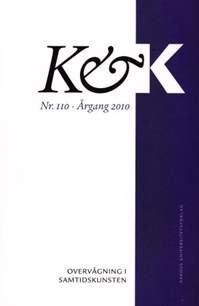FRA BIG BROTHER TIL TOILETKUMMER OG MEKANISKE PROTESER – OM KUNST SOM RESSOURCE FOR OVERVÅGNINGSFORSKNING
DOI:
https://doi.org/10.7146/kok.v38i110.15772Keywords:
overvågning, Big Brother, panopticon,Abstract
FROM BIG BROTHER TO TOILET BOWLS AND MECHANICAL PROSTHESES: ART AS RESOURCE FOR STUDYING SURVEILLANCE
For years the concepts of Big Brother and panopticon have dominated the way surveillance is perceived in public debate as well as academic research. Taken together these two concepts substantiate an understanding of surveillance as related to situations of total visibility. Nowhere can citizens escape the all-encompassing gaze of the surveyor. Furthermore surveillance is understood as an automatic process carried from a centre, which is so powerful that resistance is hopeless.
Within the field of surveillance studies it has been acknowledged however that this understanding is too narrow and limited, and a search for novel theories and concepts of surveillance has begun.
This article argues that contemporary art contains resources that enable an understanding of surveillance as a multifaceted phenomenon. This point is illustrated by analysing Hasan Elahi’s “Tracking Transience: The Big Brother Project” as well as various attempts by Stelarc to upgrade the human body. In sum these artists subvert and extend the concept of surveillance. For example Elahi shows how it is possible for the surveyed to distort the vision of Big Brother and take control over the surveillance situation. In a somewhat different way Stelarc constructs experiments in which the body is linked to surveillance tech nology, but this is done in order to share information and power and with the intent of empowering the body. Surveillance tech nologies are thus not seen as part of a totalitarian regime, but as a possibility for upgrading the body to fit a complex environment.
In a situation where even more sophisticated surveillance tech nologies are deployed to almost every corner of everyday life it becomes essential to understand surveillance as an integrated part of society. Although the academic field of surveillance studies contributes to this understanding, it is at the same time limited by the use of a few powerful metaphors. However, by looking at the many interesting examples of artists experimenting with surveillance, the study of surveillance might be able to regain its analytical imagination.
Downloads
Published
How to Cite
Issue
Section
License
Tidsskriftet følger dansk ophavsret.





